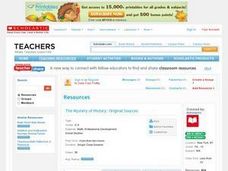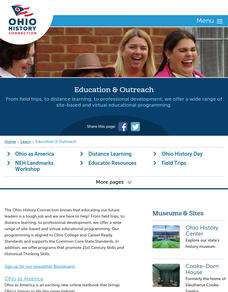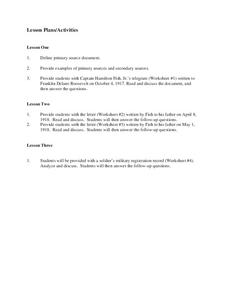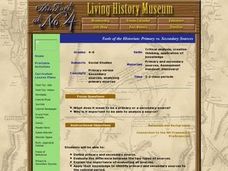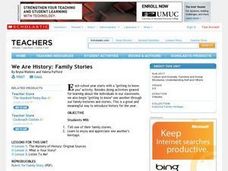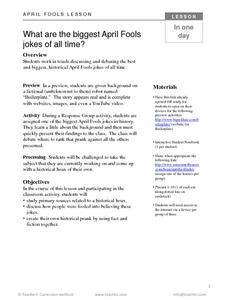Curated OER
Native Americans of the Chesapeake Bay: Using Primary vs. Secondary Sources
Discover the rich Native American culture that existed at the time of early European exploration into the Chesapeake region through analysis of several primary and secondary sources.
Curated OER
The Mystery of History-Original Sources
Students research the events surrounding the Alamo in 1863, and explore the differences between primary and secondary sources of information. They brainstorm lists of items used to research a subject and categorize them as primary or...
Center for History and New Media
Slavery and Free Negroes, 1800 to 1860
What was life like for enslaved and free black people before the American Civil War? Explore the building tension between states and the freedom of individuals with a thorough social studies lesson. Learners of all ages explore primary...
Curated OER
Using Primary Source Documents
Students examine copies of primary source documents and determine the document's value to a researcher. They analyze and evaluate the document for bias or contradiction. They know the difference between a primary and secondary source.
Curated OER
Primary and Secondary Sources
Students understand what primary and secondary sources are. For this primary and secondary sources lesson, students take a list of sources and break down to primary and secondary sources.
Curated OER
Introduction to Primary Sources
Students explore the usage of primary sources, what they are and how they originate. Artifacts are compared and contrasted as part of this historical inquiry as questions are formulated and conclusions drawn.
Curated OER
Communities in Crisis Lesson 1: Primary Source? What is That?
Distinguish between primary and secondary source documents using the theme of philanthropy. Middle schoolers discuss Anne Frank: The Diary of Young Girl as a way to study the past using a primary source. Then they investigate how to...
Curated OER
Understanding Primary and Secondary Sources
Students identify legends in Tennessee and U.S. history, and differentiate between primary and secondary sources. They list examples of primary and secondary sources, participate in a field trip to the Country Music Hall of Fame, and...
Curated OER
Primary and Secondary Sources
Students complete worksheets having to do with primary and secondary source documents. In this sources lesson, students define a primary source document, look at examples of primary and secondary sources. Students complete multiple...
Briscoe Center for American History
Identifying Primary Source Documents
Who is Mary Maverick and why is she important? the focus of this, the second in a series of five lessons that are designed to introduce middle schoolers to how historians use primary source documents to understand the past, is on how to...
Curated OER
Tools of the Historian: Primary vs. Secondary Sources
Students identify the difference between primary and secondary sources. They discuss the importance of evaluating all sources they might use. They read primary and secondary sources that relate to the colonial period.
Curated OER
The Crittenden Conway Duel
Young scholars explore primary and secondary sources. In this primary and secondary source activity, students investigate a crime scene. Young scholars search for evidence around the classroom and evaluate their findings. Students write...
Curated OER
We Are History: Family Stories
Young scholars examine their own family heritage and share family stories with the class. They differentiate between primary and secondary sources, and bring in and write about three artifacts from their family. They conduct an...
Curated OER
African American Experiences: Window to the Past
Students examine African life during slavery on the Internet. In this slavery lesson, students use the Internet to research slavery and create a scrapbook. Students review pictures of slavery and label them as primary or secondary sources.
Curated OER
Signature History
Young scholars review the meaning and application of primary and secondary sources in research. They determine how researchers locate primary source documents before looking at signatures as a validating factor on many primary sources....
Curated OER
Slavery in America at the Time of the Civil War: Sources
Students discover how to use primary and secondary sources in research. In this Civil War lesson, students conduct research on slavery as they distinguish between primary and secondary sources regarding the same events.
National Woman's History Museum
Defying British Rule: Women's Contributions to The American Revolution
Primary and secondary sources are the focus of a lesson that showcases the important role women played during the American Revolution. Pairs review sources and discuss their findings. A close-reading of an informational text leads the...
Curated OER
Abigail’s War: The American Revolution through the Eyes of Abigail Adams
Four lessons, performed over four weeks, pay special attention to Abigail Adams. Fifth graders analyze primary and secondary sources, read texts, discuss and write about Adams' experience during the Revolutionary War—the Battle of Bunker...
Curated OER
Social Studies: Primary and Secondary Sources
Students assess the information contained in primary and secondary sources and discuss the differences between them. They examine the diary of a World War I soldier with a textbook account to determine the validity of each. As a...
Curated OER
Anti-Slavery and Reform-Related Sources
Fifth graders use primary sources to explore events witnessed by ordinary people. In this primary documents lesson, 5th graders answer critical thinking questions based on their documents. Students recognize the difference between...
Curated OER
Real-Life History: Looking at Our Community
Spend several days with your class exploring local history. Learners brainstorm and categorize sources of historical information as primary or secondary; collect and present artifacts from family/community; construct a definition of...
TCI
What Are the Biggest April Fools Jokes of All Time?
After working in groups to analyze primary sources related to a historical hoax, learners will discuss how people managed to be fooled and work to identify one of the biggest April Fools jokes in history.
Curated OER
Studying the Life of Henry Bibb
After reading primary and secondary source materials about the life of Henry Bibb, individuals identify a core democratic value Bibb demonstrated and give examples drawn from their readings.
TPS Journal
Sourcing a Document: The First Thanksgiving
How reliable is a painting of the first Thanksgiving if it was created 300 years after the fact? Learners assess the validity of a primary source image to determine what it can actually reveal about this event.



